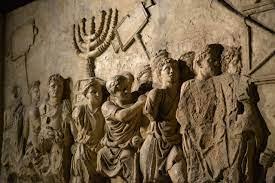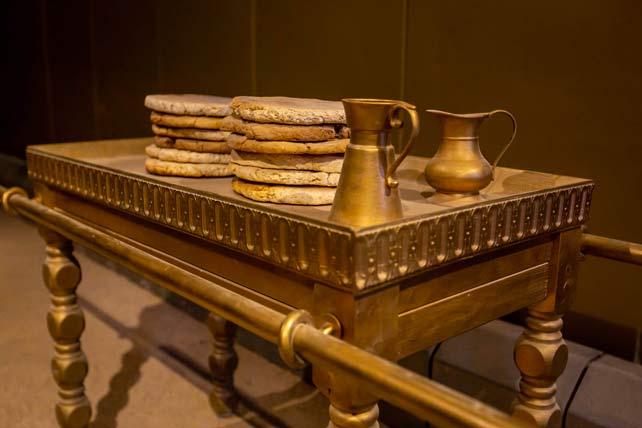Holiness in the Sanctuary
24: 1-9
Holiness in the Sanctuary DIG: Why did God need oil lamps and bread? How would those things function in the Israelites everyday life? How does this help to explain why they are included in the Torah? Why was the frankincense burned separately? How was it holy?
REFLECT: Do you burn more energy in your diligence for the Lord, or for your own work? What are the important things in your life? How do you give these things to God? What does this say about your relationship with Him? How are being a light to the world today?
These rites served to acknowledge the Holy King’s presence and to request His divine favor.
The transition from the festival calendar which climaxed in the magnificent Feast of Sukkot (to see link click Eg – Hag Sukkot), to the lesser articles of furniture in the Sanctuary illustrates the believers’ faithfulness to YHVH in the daily routine of life and not just during spiritual mountaintop experiences. Perhaps the purpose of this seeming digression (before matters pertaining to the holy calendar resume in Ch 25), was to dispel the notion that God’s presence might be limited to special occasions of worship, since both articles of furniture were closely related to the continued presence of God in Isra’el’s midst. Between the celebration of God’s appointed times (23:1-2), unbroken daily fellowship in the Temple was to continue without interruption.470

The continually burning lampstand (24:1-4): Like Leviticus Chapter 8, this section is closely connected to the book of Exodus. The plans for the structure of the lampstand (menorah) are given in Exodus 25:31-40, while the actual construction is described in Exodus 37:17-24 (see the commentary on Exodus Fn – The Lampstand in the Sanctuary: Christ, the Light of the World). ADONAI said to Moshe, “Order the people of Isra’el to bring you pure oil from crushed olives (Exodus 27:20-21). Any olive oil burns, but only the purest from the first pressing could be brought into the Holy Place. It would keep the lamps on the lampstand burning continually since they provided the only light in the Holy Place. The mitzvah for the continual kindling of the lamps had been given earlier by Moshe in Exodus 27:20-21. Here the igniting of the lamps is actually being implemented. The location of the lampstand is described as being outside the inner veil (see Exodus Fq – The Inner Veil of the Sanctuary: That is Christ, His Body) of the testimony (the Ten Commandments placed in the Ark of the Covenant) in the Temple. Aaron is to arrange for the light to be kept burning always from evening until morning before ADONAI; this is to be a permanent regulation through all your generations. He is always to keep the lamps in order on the pure menorah before ADONAI.

Later in Isra’el’s history, the lampstand was in fact captured by the Roman general Titus during the destruction of Jerusalem and the Temple in 70 AD (see the commentary on The Life of Christ Mt – The Destruction of Jerusalem and the Temple on Tisha B’Av in 70 AD). On the arch of Titus in Italy, the Roman soldiers are displayed carrying the lampstand from the City of David. The lampstand became one of the best-known symbols of Judaism, and its depiction has been found on a coin from the reign of Antigonus (40-37 BC).471
In the B’rit Chadashah the Lord Yeshua Messiah becomes the light Who opens the way to the Father (see The Life of Christ Gr – I Am the Light of the World). As the Messiah of Isra’el, He fulfills the call for Isra’el to be the light to the nations (Isaiah 42:6, 49:6 and 60:3). And those who share in His ministry are also lights – both individual believers (see The Life of Christ Df – You are the Salt of the Earth and the Light of the World), and churches (see the commentary on Revelation Al – I Turned Around and Saw Someone like a Son of Man). They are lampstands because they are empowered by the Ruach Ha’Kodesh to show the people the way to the Father through the Son.472

The bread of God’s presence (24:5-9): The Israelites were not only to provide oil, but also bread for the Sanctuary. Twelve loaves, representing the twelve tribes of Isra’el, were to be baked and set in two rows, six in each row, on the table of showbread that stood before YHVH in the Holy Place. Those loaves came to be called the bread of the Presence (see the commentary on Exodus Fo – The Bread of the Presence in the Sanctuary: Christ, the Bread of Life) because they were placed in the presence of (literally: to the face of) ADONAI. By presenting those loaves of bread every week the twelve tribes acknowledge that God supplied food for His people.473 The recipe for the bread appears only here. You are to take fine flour and use it to bake twelve loaves, using two-tenths of an ‘efah, or about 2.2 liters per loaf. Arrange them in two rows, six in a row, on the pure table before ADONAI (24:5-6).

The practice of displaying bread in the Sanctuary is very ancient. There is a reference to this offering in an account from the early career of David. While fleeing from King Sha’ul, David and his men arrived at the Sanctuary of Nov and were given some of the Bread of the Presence to eat. According to the Torah, only the priests were permitted to partake of the consecrated loaves and, then, only within the courtyard of the Tabernacle (see Exodus Ex – The Courtyard and Gate of the Tabernacle). The TaNaKh records that Ahimelek the high priest had to be assured that David’s fighting men had kept themselves pure from women before permitting them to eat of the bread of the Presence (see the commentary on the Life of David Av – David at Nov).
Put frankincense with each row to be an offering made by fire to ADONAI in place of the bread and as a reminder of it. Frankincense was also an ingredient of the incense. Here, its function was that of a “token portion” (Hebrew: ‘azkarah). In most of the grain offerings, a small the “memorial portion” was placed on top of the burnt offering (see Ai – The Burnt Offering). In effect, two different modes of sacrifice were reflected in the offering of the bread of the Presence. The loaves themselves were a presentation to Ha’Shem for which no burnt offering was used. The bread was viewed by God and, by this means, accepted by Him. Subsequently, the loaves were given to the priests. In an effort to adapt this widespread mode of sacrifice to the more distinctive method of burning offerings on the bronze altar, frankincense was to be burned near the loaves of bread; just as the other grain offerings, a “memorial portion” of flour was burned on the altar. The LORD was pictured as inhaling the aroma of the burning frankincense, which served as an offering by fire. In Mishnah Menahot 11:5, we are told how the frankincense was burned during the Second Temple period. Two containers (Hebrew: bazikhim) were placed near the rows of loaves for that purpose.474
Bread and pure frankincense were to be supplied each Sabbath. Regularly, every Shabbat, he is to arrange them before ADONAI; they are from the people of Isra’el, as a covenant forever. It was food for the priests. Later, we find that the Kohathites specifically had the responsibility for the loaves of bread (First Chronicles 9:32 and 23:29). They will belong to Aaron and his sons; and they are to eat them in a holy place; because for him they are, of the especially holy offerings for ADONAI made by fire (24:7-9). This is a permanent mitzvah. The bread, which was only separated from the Most Holy Place by the inner vail, was closely associated with the covenant and was a symbol of fellowship with YHVH (First Samuel 4:5; Amos 4:4; Mark 14:22 and John 6). The bread thus symbolized the covenant that Ha’Shem had established with Isra’el.475
The bread the people brought was a token of God’s provision of food that the people were enjoying. But as it lay on the table in the Holy Place in the Sanctuary it signified all the LORD’s provision for His people, both physical and spiritual. In the B’rit Chadashah the Son of Man demonstrated that He could provide bread for His people (see the commentary on The Life of Christ Fn – Jesus Feeds the 5,000); but the real bread they needed was food for their souls, and so He declared that He was the bread of life that the Father had sent (see The Life of Christ Fr – Jesus the Bread of Life).476



Leave A Comment